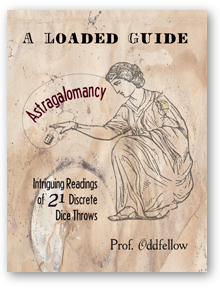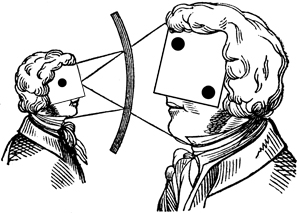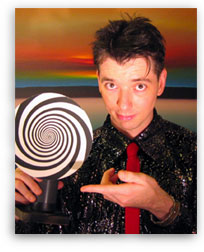|

|
Astragalomancy: A Loaded Guide Intriguing Readings of 21 Discrete Dice Throws  There is perhaps no better way to conjure up the spirit of great antiquity than to roll dice. The very ancient game of throwing knucklebones dates back to the Trojan War (ca. 1194–1184 BCE), if we are to take Sophocles’ word. The original knucklebone was technically a bone in a sheep’s ankle, the astragalus, hence divination by astragalomancy.
There is perhaps no better way to conjure up the spirit of great antiquity than to roll dice. The very ancient game of throwing knucklebones dates back to the Trojan War (ca. 1194–1184 BCE), if we are to take Sophocles’ word. The original knucklebone was technically a bone in a sheep’s ankle, the astragalus, hence divination by astragalomancy.The great Greek philosopher Plato traced dice even farther back, to the ibis-headed Egyptian god Thoth, inventor of magic and writing and science, divine arbitrator, judge of the dead, and maintainer of the universe. Plato himself played dice not only with cubes but also tetrahedrons, octahedrons, dodecahedrons, and icosahedrons — the famous “Platonic solids” of geometry. Plato said, “God geometrizes,” and that’s a key to why dice have always been associated with divination — the geometric solids, as building blocks of the universe, embody truths on higher planes. Over the centuries, several rules have been associated with throwing dice for divination. “However, it is entirely a matter of personal choice whether these are followed or ignored. Many of these rules are arbitrary and were probably developed to add mystery and significance to divination by dice. Do not be afraid to develop your own guidelines, nor to be completely spontaneous, using the dice in different ways according to your instincts at the time. Trusting your instincts is the best way to get a good reading.” CONTENTS
|
|||||||||||||||||||||||||||||||||||||||||||||
 |
About the AuthorCraig Conley is a magic enthusiast and scholar. Recognized by Encarta as “America’s most creative and diligent scholar of letters, words and punctuation,” his intensive and eccentric research has led him to compile a true masterwork entitled Magic Words: A Dictionary. He has also authored One-Letter Words: A Dictionary, among other strange and unusual lexicons, and is a regular columnist for Pentacle magazine. Conley’s ideas are often decades ahead of their time. He invented the concept of the “virtual pet” in 1980, fifteen years before the debut of the popular “Tamagotchi” in Japan. His virtual pet, actually a rare flower, still thrives and has reached an incomprehensible size. Featured Works: Published Works |
|||||||||||||||||||||||||||||||||||||||||||||
|
|
Online Resources |
|||||||||||||||||||||||||||||||||||||||||||||
A free daily symbolic outlook
|
||||||||||||||||||||||||||||||||||||||||||||||